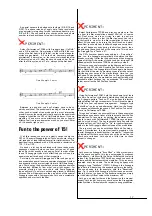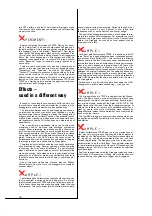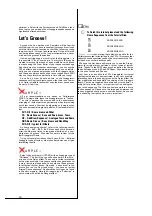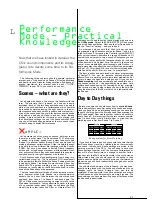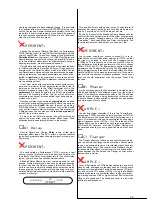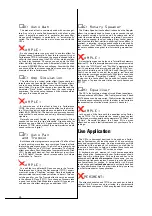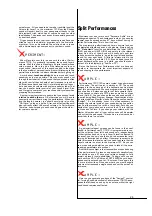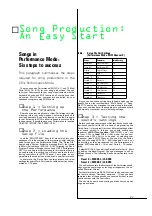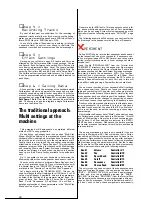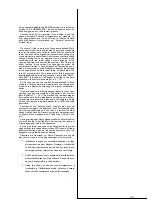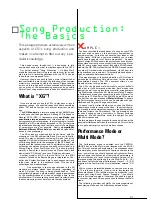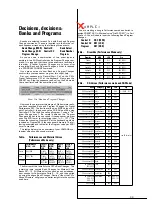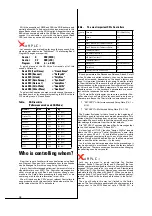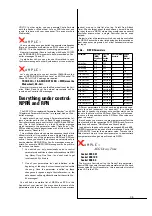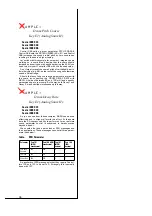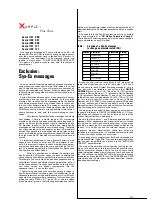
22
Why Scenes?
Most startling first and foremost is the blending of two dif-
ferent sounds, which as we have already pointed out is com-
monly known as morphing. Most sound programmers using
sample-synthesizers work with contrasting level modula-
tions for two or more partial tones. With the CS1x this, the
simplest and easiest method, is achieved with the aid of
Assign2, i.e. Knob 6. By the way: if you haven‘t fully
aquainted yourself with the Assign1/2 parameters and func-
tions, we would recommend you read though the relevant
pages in your manual. Never fear, morphing is much more
easily achieved than you may think. The next example should
help you understand the rules involved.
A M P L E :
Select Performance TP095. Naturally you need to activate
both Scene switches (the LEDs will light up). So much for
the preparation, now let‘s have some fun: hold any note and
‘morph’ between Scene 1 and 2 using the Mod wheel. You
are now actually blending between a square wave (Scene1)
and a sawtooth wave (Scene2). A glance behind the scenes
reveals the programming involved. Find the Assign2 page.
The Performance is made up of two partial tones. Both com-
ponents are assigned Volume modulation, however using
different modulation intensities. The first Layer is set to a
negative value (-32), the second with a matching positive
one (+32) – this is the real trick. Result: turn Knob 6 fully
clockwise to hear the Layer1 sound (Ld: Volfet A) and fully
counter-clockwise to hear the Layer2 sound (Ld: Volfet B).
The same process can be used to create other morphing
sounds. If this type of Performance appeals to you, use
TP095 as a starting point. Make sure you use plenty of con-
trasting sound combinations. As always, X-PERIMENTing is
everything!
A Performance doesn‘t always need to change so signifi-
cantly as with the previously described level modulation.
Impressive sound developments can also be achieved with-
out the help of Assign1/2. Modulating only Filter and Enve-
lopes can be interesting enough, especially where analogue
synthesizer sounds are concerned!
A M P L E :
Select Performance TP096. Here a heavily filtered and res-
onanced sawtooth with minimal fade-in and out times is
transformed into a harmonically rich pad sound with the
usual envelope curves. Other parameters apart from the filter
sweep (achieved with only the Filter‘s cutoff point) are
affected as well. This gives the sound more universal appli-
cations. Let‘s stay with this Performance a little while, but
this time deactivate the two scenes. Particularly noteworthy
are the two assignable knobs: play a little with Knob6. If you
listen carefully you will notice that turning the knob anti-
clockwise causes LFO Amplitude modulation, whilst a clock-
wise turn results instead in LFO Filter frequency modulation.
Let‘s now concentrate on the Assign1 knob. This is set to
enable you to transpose the entire Performance‘s pitch by +/
- 2 octaves. In contrast to the Pitch modulation with Assign2,
the pitch can be changed continuously, without the usual
semi-tone steps. Consider Knob 3 as an additional Pitch
wheel.
Let‘s leave this aside for a moment: Why not assign Knob3
or Knob6 with Filter modulation? But which should you
choose? The central parameters Cutoff frequency and Reso-
nance already have their own dedicated knobs, so they are
out of the equation. The following example might give a pos-
sible answer to this question.
A M P L E :
You have selected Performance TP097. This is a classic lead
sound, which thanks to Scene morphing can be played very
expressively. Aside from the Filter frequency, the Filter Enve-
lope‘s fade-in and out times are also modulated; this time
Assign1 is responsible for the fade-out phase. All three
Layers of the Performance have to use the same fade-in value
if the fade-in times are to be modulated consistently (FEGAt-
kTime=+32). Scene1‘s settings result in intense filtering and
a very drawn-out fade-in time. Holding down any key for
more than 10 seconds will show how slow the fade-in phase
really is. Not so with the second Scene. Here the Filters’
fade-in time is minimal and is markedly ‘opened’ – so, can
you guess what happens during Scene morphing…?
Let‘s look at Pan position modulation. Marked left-right
movements within the stereo image don‘t really cause a sen-
sation these days. Great fun can be had however if other
parameters are modulated in harmony. This really is the
secret of every effective Pan modulation! Let your imagina-
tion roam free. For example, choosing the oft recited Filter
modulation can never be wrong.
A M P L E :
For this, too, we have prepared a little sound example
(TP098). There is no need to work with opposite modulation
intensities here as the Performance contains only the one
Layer – the Assign2 setting “Pan+32” will suffice. Now to
the Scenes: here the Performance is filtered quite differently
and two completely different Pan positions are used. Mor-
phing from Scene1 to Scene2 will result in a filter sweep
with the added tension of the left-right movements.
In contrast to all our previous Scene examples which
focused exclusively on analogue synth sounds, we would like
to finish with an example to show that conventional sounds
too can be played more dynamically with Scene morphing.
We have just touched on one of the classic weaknesses of
ROM-Sample-Synthesizers. A waveform is simply repro-
duced and can often seem very static. Scene morphing is a
new form of modulation that, whilst not solving the problem
completely, may contribute some new and interesting ideas.
A M P L E :
String sounds in particular are used in many different
forms with sequencer arrangements. Often you will have uti-
lised a variety of sounds to better imitate playing techniques
such as Marcato or Pizzicate. You can‘t honestly say though
that you were completely happy with this approach. The crux
of the matter are the envelopes; they should react to your
playing technique but instead you have to adapt your playing
to them. Here the Scenes can provide a lot more flexibility.
Why not try this out for yourself with Performance TP089.
After a short while you will find that Scene morphing allows
the string sound to be phrased much more distinctively.
The Effects
The Yamaha synthesizer offers a choice of three indepen-
dent effects – Reverb, Chorus as well as a special Variation
effect. Although you cannot program the first two effects at
the machine itself, the Variation effect offers a plethora of
parameters for you to play with. You can read up on this sub-
ject in the Appendix of the manual as well as the chapter
about song production. We would like to concentrate how-
ever on a few effect types and their parameters.
In Performance mode the Variation effect can only be used
with the Insertsetting. In contrast to the Multi mode you can
however switch the effect on and off for each Layer. There is










